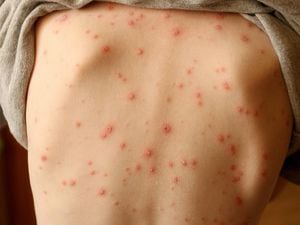Skin rash should be considered key symptom of coronavirus, say scientists
The rashes can present in a number of different ways, and in some cases persist for weeks, researchers say.

A rash could be another symptom of coronavirus, and scientists are advising people to self-isolate and get tested if they notice a new rash.
Researchers say that characteristic skin rashes and “Covid fingers and toes” can occur in the absence of any other symptoms and therefore should be considered when diagnosing Covid-19.
A persistent cough, fever and a loss of smell or taste are listed by the NHS as the main symptoms of the virus.
Using data from the Covid Symptom Study app from about 336,000 regular UK users, King’s College London researchers found that 8.8% of people testing positive for the disease had experienced a skin rash as part of their symptoms.
This was compared with 5.4% of people with a negative test result.
Similar results were seen in a further 8.2% of users with a rash who did not have a coronavirus test, but still reported classic Covid-19 symptoms, such as cough, fever or anosmia.
The study authors write: “This study strongly supports the inclusion of skin rashes in the list of suspicious Covid-19 symptoms.
“Although it is less prevalent than fever, it is more specific of Covid-19 and lasts longer.
“An increased awareness from the public and healthcare professionals regarding Covid-19 skin changes will allow more efficient identification of new and earlier clusters of the disease.”
According to a pre-print of the study, which has not been peer-reviewed, 17% of respondents testing positive for coronavirus reported a rash as the first symptom of the disease.
And for one in five people (21%) who reported a rash and were confirmed as being infected with coronavirus, the rash was their only symptom.
Lead author Dr Veronique Bataille, consultant dermatologist at St Thomas’ Hospital and King’s College London, said: “Many viral infections can affect the skin, so it’s not surprising that we are seeing these rashes in Covid-19.
“However, it is important that people know that in some cases, a rash may be the first or only symptom of the disease.
“So if you notice a new rash, you should take it seriously by self-isolating and getting tested as soon as possible.”
Consultant dermatologist Dr Justine Kluk said: “These findings highlight the importance of keeping an eye on any new changes in your skin, such as lumps, bumps or rashes.
“Early reporting of Covid-associated rashes by members of the public and recognition of their significance by frontline healthcare practitioners, such as GPs, NHS 111 and hospital staff, may increase the detection of coronavirus infections and help to stop the spread.”
The rashes associated with the virus fall into categories – hive-type rash (urticaria), prickly heat or chickenpox-type rash (erythemato-papular or erythemato-vesicular rash), and Covid fingers and toes (chilblains).
The hive-type rash is a sudden appearance of raised bumps on the skin which come and go quite quickly over hours and are usually very itchy.
It can involve any part of the body, and often starts with intense itching of the palms or soles, and can cause swelling of the lips and eyelids.
They can present quite early on in the infection, but can also last a long time afterwards.
Prickly heat or chickenpox-type rashes see areas of small, itchy red bumps that can occur anywhere on the body, but particularly the elbows and knees as well as the back of the hands and feet.
It can last for days or weeks.
Covid fingers and toes see reddish and purplish bumps appear on the digits, which may be sore but not usually itchy.
Researchers say this type of rash is most specific to Covid-19, is more common in younger people with the disease, and tends to present later on.
While rashes had been reported in a number of cases of people in China and Europe who had been hospitalised with severe symptoms of the disease, scientists say, this is the first and largest study to systematically gather data about skin rashes in milder cases in the wider population.





